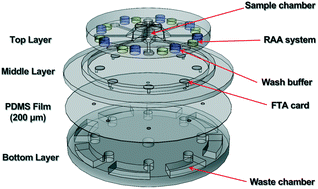Automatic and multi-channel detection of bacteria on a slidable centrifugal disc based on FTA card nucleic acid extraction and recombinase aided amplification†
Abstract
Rapid screening of foodborne pathogens is key to preventing food poisoning. In this study, a slidable centrifugal disc was developed for automatic and multi-channel detection of Salmonella typhimurium using Flinders Technology Associates (FTA) cards for nucleic acid extraction and recombinase aided amplification (RAA) for nucleic acid detection. The slidable FTA switching and centrifugal fluidic control were elaborately combined to achieve fully automatic operations, including centrifugation of the bacterial sample to obtain the concentrated bacteria, heating and drying of the FTA card to extract the nucleic acids, washing of the FTA card to remove the impurities, and RAA detection of the extracted DNA to determine the concentration. Under the optimal conditions, this slidable centrifugal disc was able to detect 10 CFU mL−1 in a spiked chicken meat supernatant in 1 h with an average recovery of 101.8% and an average standard deviation of 6.5%. This disc has been demonstrated as an alternative for sample-in-result-out detection of Salmonella and has shown potential for simultaneous detection of multiple bacteria.



 Please wait while we load your content...
Please wait while we load your content...